Homesteading with pigs offers a plethora of delicious and money-saving possibilities. With proper shelter and sturdy fencing, pigs don’t require much space and can be raised even on small homesteads, and not merely on large rural farmland where I am blessed to live.
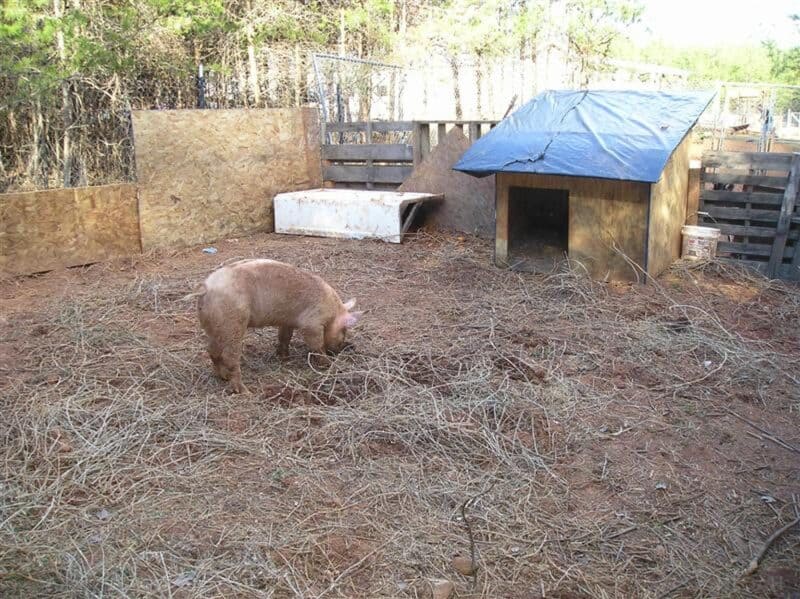
Pigs (or hogs as we call them in my part of Appalachia) grow quickly, and can be butchered in a single year.
Except for any breeding pair you might elect to keep, there is no need to suffer the expense and work of wintering over the livestock.
Preparing for the addition of pigs to your homestead barnyard is crucial, even if you are purchasing only “weaner” pigs that will be butchered come fall.
Regardless of the hog breed you choose to keep, they are strong animals that can push through all but the sturdiest of fencing by the they are just a few months old.
Before bringing pigs onto the homestead make sure make or get the following:
- find a spot that provides both warming sunshine and plenty of shade
- a wallow or baby pool to cool off in, a shelter with at least three sides to protect the hogs from the elements (but four sides is better so the pigs can be shielded from predator attacks)
- install a pen fence comprised of hog panels attached to hardwood posts
- perhaps even set up some strands of electrical fencing to deter the hefty animals from even touching their perimeter fencing
When pigs become a part of the homestead as little weanlings you must remind yourself (and likely your children) that they are meat animals, and not pets.
If you have never kept hogs before you might think it is impossible to look at a pig as cute or get emotionally attached to them – but trust me, it happens more often than you think.
Do NOT name your pigs, except for possibly a breeding pair!
Put a number tag on them if you must to be able to tell them apart for health check and weigh in purposes,.
Do NOT give into any attempt by a child or even your inner child, to name or nickname animals you want to turn into tantalizing bacon, scrumptious holiday ham, or tender pork loin that is cooked to perfection in a smoker.
Table of Contents:
Types of Pig Breeds
Two traditional types of hogs have been raised on homesteads and farms in America: for bacon and for lard.
Bacon pigs breeds are raised to be more muscular than lard pigs. These hogs put on weight more slowly than lard pigs because they are a low-energy type of livestock that feasts upon a high protein count diet of typically legumes, grains, and turnips
A bacon pig like a Tamworth or a Yorkshire develops a body that is nearly entirely composed of fat and muscle.
Lard Pigs boast a more compact body style than bacon pigs. These breeds of hogs are usually shorter than bacon pigs, and live on a diet mostly comprised of corn. Lard pigs will gain weight far quicker than bacon hogs.
Traditionally, lard pigs were raised for their fat for cooking and baking, as well as to be used to make machinery lubricant and explosives (but that practice basically ended at the end of World War II).
Many top-quality lard pig breeds disappeared or became endangered after their lard was no longer a hot commercial commodity (which in my personal opinion disproves the vegetarian notion that not eating meat saves the lives of threatened animal breeds).
But, investing in a lard pig merely for a free and rich source of fat for baking and cooking is still common on small family farms, homesteads, and off grid households.
The leaf lard (or white fat that is present around the kidney area of the hog) is harvested and then rendered for use in the kitchen.
I am a strong proponent of heritage livestock breeds in general and especially so when it comes to quality meat hogs.
By and large, heritage breeds have held onto the climate and disease hardy traits of their ancestors as well as their ability to live primarily independent lives without the need of aids offered by human intervention.
Although it takes longer for heritage pig breeds to put on weight than commercially bred and crossbred varieties, their meat (as well as the meat, milk, and eggs produced by other heritage livestock breeds) is usually far more delicious, moist, and leaner than that of conventional modern breeds.
The micro-marbling of the hog meat tends to produce a delicious and unique flavor that is also self-basting.The life expectancy of heritage breed pigs typically exceeds that of conventional and crossbred hogs. A heritage breed mating pair of pigs can often live between 12 and 20 years.
If you keep heritage breed pigs on your homestead you can often expect them to rapidly adapt to hot or cold climate changes – provided they have an adequate shelter to protect themselves from the fluctuations in heat and precipitation.
Not all of the top pig breeds on the list below will be heritage pigs, but most are. The only downside to raising heritage hog breeds is the extra time and sometimes extra money it takes to find them.
Purchasing heritage breed pigs may mean that you have to drive outside of your county or region to find them instead of purchasing a good quality non-heritage breed from a neighboring homestead or local livestock auction.
On the plus side, if you do decide to raise heritage pig breeds on your homestead, you just might have opened up a steady side revenue stream from breeding these exceptional bacon style pigs.
Top Pig Breeds to Raise on Your Homestead
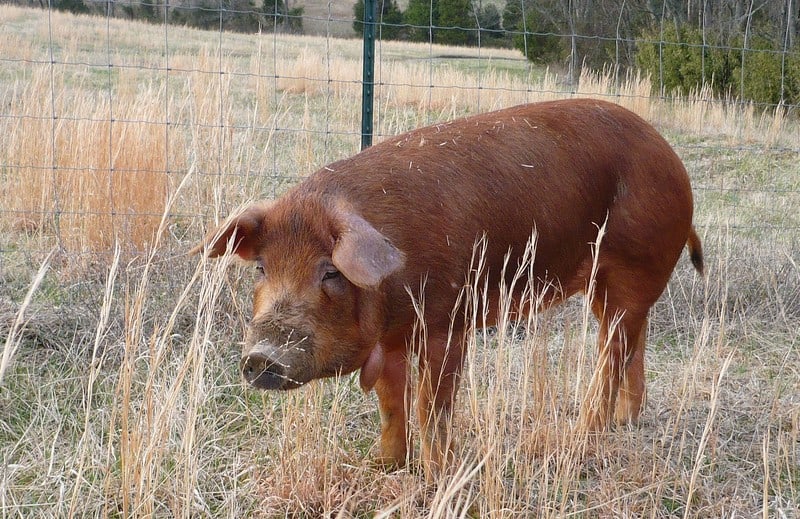
1. Red Wattle
This heritage hog breed is often regarded for its docile nature and longevity. Even newbie keepers often have no problem dealing with a large boar or high strung sow.
The first few hours to days on the homestead makes all the difference in how red wattle pigs will adjust to both their new keepers and surroundings.
For best results, do not move too quickly or chase the hogs into their pen. Guide them gently yet firmly to where they need to go using a cane or thick stick – while talking to them.
Red Wattle hogs generally are soothed by the sound of human voices, and this initial interaction will help build a rapport with the animals that creates the trust needed to easily maneuver them, as well as to garner the ability to apply quick treatment if they become sick or injured.
Red Wattle pigs are excellent grazers, and can offer a moist and flavorful meat when raised on nothing more than forage and pasture areas – making them a highly economical hog breed to raise.
If you are short of either forage or pasture space, red wattle hogs can be raised in a pen environment, as well.
Red Wattle Pig Facts
Mature male hogs of this heritage breed weigh 700 to 800 pounds on average, but some can weigh in at more than 1,000 pounds. Sows generally weigh roughly between 600 to 700 pounds when they reach maturity.
A mature Red Wattle hog is capable of producing a hanging meat weight of 200 pounds.
Although these excellent homesteading pigs are primarily always red in color, some of them develop black spots and patches of black all over their bodies.
These pigs have ears that droop substantially, especially at the tips.
Red Wattle pigs can be easily startled when walked up upon from behind. Talking to them to announce your presence will go a long way in thwarting this type of unwanted behavior.
Startling a 1,000 pound animal inside of its domain rarely ever goes well for the human “invader”.
Sows are typically superb mothers and farrow (give birth) without issues or the need of human aid.
A common Red Wattle litter will produce between 10 to 15 baby pigs at least two but sometimes three times per year. If you are going to either breed pigs for sale or put up a lot of meat, this heritage breed will offer ample offspring to successfully accomplish either goal.
Red Wattle meat is known to be both tender and lean.
Red Wattle Pig History
The breed got its name from the large wattle that sticks out on the sides of their necks. This breed is believed to have originated in east Texas in the early 1970s.
H.C. Wengler discovered a herd of wild Red Wattle pigs and started to breed them using his own selective breeding techniques.
About a decade later, Robert Prentice also discovered a herd of wild Red Wattle hogs in the woods and started a dedicated breeding of the animals with his Timberline pigs as well.
Exactly where the Red Wattles came from still remains a mystery. The running theory is that these hogs arrived in America with pioneering settlers.
The ones that were able to break out of their pens over the years formed their own herds that roamed free in the woods.
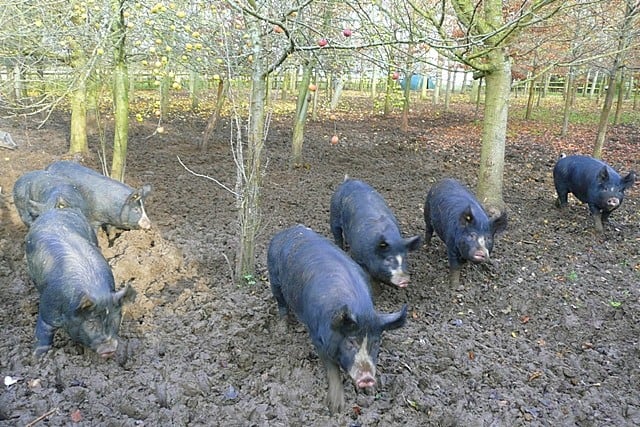
2. Berkshire
Berkshires are another excellent choice for homesteaders who want to raise hogs. These tender meat producers do best in Midwestern or colder climates.
While Berkshire pigs are incredibly cold weather hardy, they tend to sunburn more than other light hair colored breeds.
Commercial farms with their massive feedlots are not fond of Berkshires because they are not rapid growers. But the truly delicious taste of their meat has maintained their popularity on family farms and homesteads.
While they are not a good foraging hold, as a heritage breed they do root for their own food quite well, and thrive in a pasture environment.
The ability to adapt to varying environments as well as their hardy, human friendly, docile, and curious nature of Berkshires also make them a good fit for new keepers.
Berkshire Pig Facts
- Mature sows weigh roughly 400 pounds on average (180 kgs).
- A mature Berkshire board weighs approximately 600 pounds (270 kgs).
- Berkshire sows are known for their maternal instincts, and for the ample amount of milk they provide to their large litters.
- The colors of these pigs are white, black and pink.
- Berkshire hogs have stocky legs, as well as strong and sturdy feet.
- Berkshire sows typically have 8 to 10 piglets twice a year, but some super producers can give birth to up to 16 piglets in a single litter.
Berkshire Hog History
This pig breed has been in existence for more than 700 years, and hail from the United Kingdom. Settlers brought Berkshire pigs to America during the early 1800s.
The popularity of this breed grew quickly, and the American Berkshire Association was created in 1875 – it was the first swine registry and breeders group ever created worldwide.
The Berkshire pig breed retained prime reputation, and its numbers continued to grow until the middle of the 1980s.
When factory farms started to eradicate family farms from the landscape, Berkshires were among the many traditional breeds of livestock that took a hard hit.
Commercial farms were not at all interested in the breed that produced such a succulent meat because they simply didn’t grow fast enough to make the slaughtering cost a dirt-cheap proposition.
Berkshire breeds do not thrive in confinement as do hogs of Hampshire, Yorkshire, and Duroc breeds – which made them even more unattractive to the corporate pig industry.
Independent medium-sized farms and family farms continued their steady efforts to keep producing this lean meat producing heritage breed.
Their diligent efforts paid off and Berkshire hog meat is now in high demand both domestically and internationally.
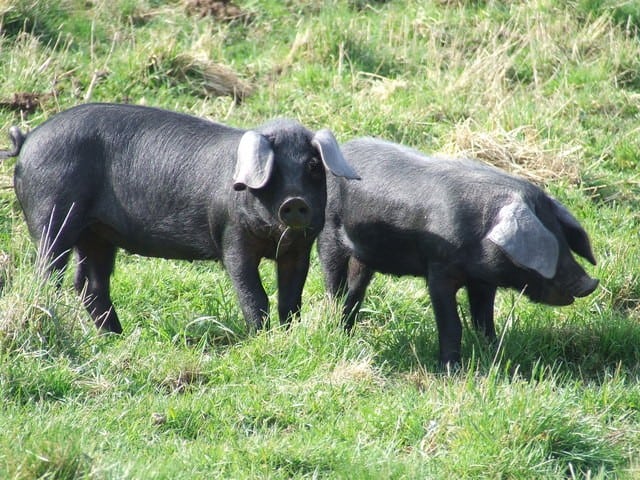
3. Large Black
The Large Black hog breed was placed on the Critically Endangered list in the early 1970s after nearing extinction one decade earlier. This breed is an excellent choice for a medium to large acreage homesteader with ample pasture and wooded areas.
Large Black hogs will fit right into any pasture management and livestock rotation plan you already use, while foraging and grazing for the vast majority of their dietary needs.
It’s an amazingly docile breed that was nicknamed the “dog” of the pig breed due to its affable nature.
Large Black pigs are known to be extremely intelligent, and so affable and entertaining that keepers tend to forget the animals are being raised to put meat on the table.
Large Black Pig Facts
- They have floppy and large ears that tend to cover their eyes.
- The original name of this pig breed was the Lop Eared Black.
- The floppy ears help shield the hog’s eyes when they are rooting deeply and foraging – which appears to be their all-time favorite activity. While their vision is obscured by their floppy ears, the physical characteristic does not seem to hamper any of their movements or cause injuries while they graze and forage.
- Mature sows typically weigh between 600 to 700 pounds (270 to 315 kgs).
- Mature boars weigh between 700 to 800 pounds (315 to 360 kgs) on average.
- Sows are prone to throwing large litters with excellent survival rates. Large Black sows are highly protective of their piglets, and are good milk producers.
- Typically, a Large Black sow delivers 8 to 10 piglets on average but can deliver litters of up to 13 baby pigs twice per year.
Large Black Hog History
This heritage breed of pigs comes from the Cornwall region of England. Large Black hogs were among the most sought after English pig breeds until their popularity peaked during the 1920s.
During this same time period, Large Black pigs were shipped from Europe to all around the world – including the United States.
This breed was not removed from the Critically Endangered list until 2015 when efforts across the world by small scale keepers started to pay off.
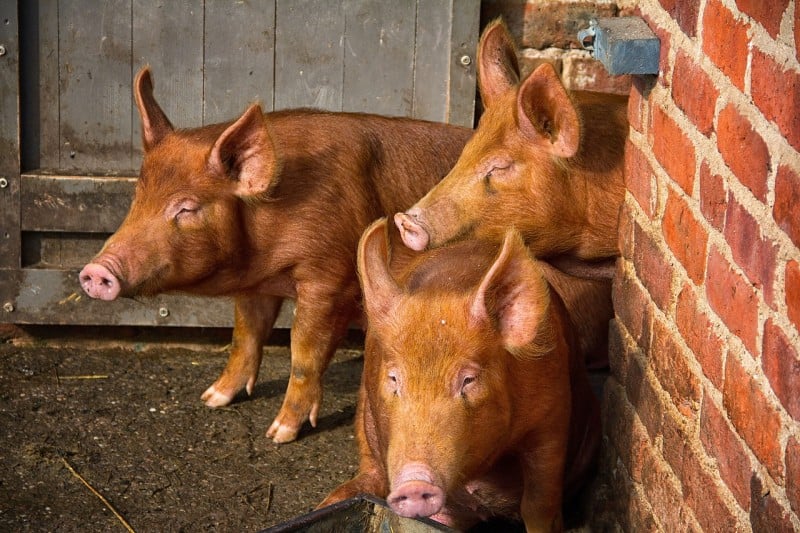
4. Tamworth
This bacon pig breed has been nicknamed “Irish Grazers” because of their all start pasture grazing tendencies. Tamworth hogs can be a bit odd-looking until you get used to the unusual silhouette their long legs and snouts pose.
Tamworth pigs are excellent at rooting and foraging. Because of the small bones that comprise these hogs, they produce among the highest percentages of usable meat.
The smaller bones of a Tamworth makes for one of the highest ratios of usable meat among heritage breeds of pigs. On average their hanging weight will be 500-600 pounds (225 – 270 kgs) for both boars and sows.
The Tamworths give birth to large litters, and have good maternal instincts.
Tamworth Pig Facts
- Tamworth sows possess solid maternal instincts and are prone to delivering litters of up to 12 piglets – sometimes more.
- A mature Tamwroth boar or sow usually produces a hanging butcher weight of around 500 to 600 pounds.
- Tamworth hogs boast a pale shade of ginger to a dark shade of mahogany body coloration.
- Unlike the other top pig breeds to raise on the homestead already noted on this list, Tamworths have pointed and clearly erect ears.
- Acorns are one of a Tamworth pig’s favorite meals.
Tamworth Hog History
These hog hail from England, and are considered to likely be direct descendents of native wild herds across northern Europe. Some of the members of this breed might have been imported by UK Prime Minister Sir Robert Peel in 1812.
On his farm in Tamworth, Peel may have crossed the Irish breed of hogs with the local pigs before the breed became “standardized” in the latter part of the 1800s.
In 1885 the Royal Agricultural Society recognized the Tamworth breed and then the registry became under the authority of the National Pig Breeders’ Association of Great Britain.
Tamworth hogs were imported to the United States and North America by Illinois farmer Thomas Bennett in 1882. The American Tamworth Swine Record Association was created in 1887.
5. Hereford
This pig breed is another great option for newbie swine keepers, and is equally popular with young 4-H members across the United States.
Hereford hogs are known for not only their docile personalities but also for their keen ability to adapt to new and varying surroundings, as well as environmental conditions.
Although Hereford pigs thrive in foraging and pasture settings (making them inexpensive and easy to feed) they also adjust quickly to pen confinement.
If you need a garden tilled up, Herefords will gladly help you with this common homesteading chore.
Herefords grow and fatten up more rapidly than the other hog breeds already detailed on this list.
Members of this hog breed closely resemble the cattle breed they share a name with: they have a white face, bellies, and legs, but have a beautiful shade of red as the coloration on the rest of their bodies.
Hereford Pig Facts
- Mature Hereford boars have a dressed weight of roughly 800 pounds (360 kgs).
- Mature sows of this breed typically weigh in around 600 pounds (270 kgs).
- Each twice a year litter from a Hereford sow typically contains 10 piglets.
- Sows are very attentive mothers and great foraging and grazing teachers to their young.
- Herefords are also highly adaptable to a variety of terrain and temperature conditions.
Hereford Hog History
This prime hog breed was created in Nebraska and Iowa during the 1920s. The breeds used to develop the Hereford line included Chester Whites, Duroc, and Poland China hogs.
The National Hereford Hog Record was created to market the breek in 1934. Hereford hogs became the most popular with farmers and homesteaders in Indiana, Illinois, and Iowa.
During the 1960s population numbers started to decline as pork industry commercial producers started to seek out swine breeds that matured quicker, and were larger overall.
Today, Hereford pigs are highly popular in the Plains and Midwestern states on agricultural land both small and large, but there are only roughly 2,000 known breeding Hereford hogs left.
6. Yorkshire
Yorkshire hogs are one of, if not the, most common swine breed in America. Members of this breed have also been referred to as English Large Whites due to their light pink colored skin that is covered with thin white hair.
Unlike some pig breeds, Yorkshires have mostly erect and only slightly droopy ears.
This breed has traditionally been regarded as bacon and not lard producing, but has been used for both purposes over the years. Yorkshires produce lean meat, and are excellent foragers and pasture grazers.
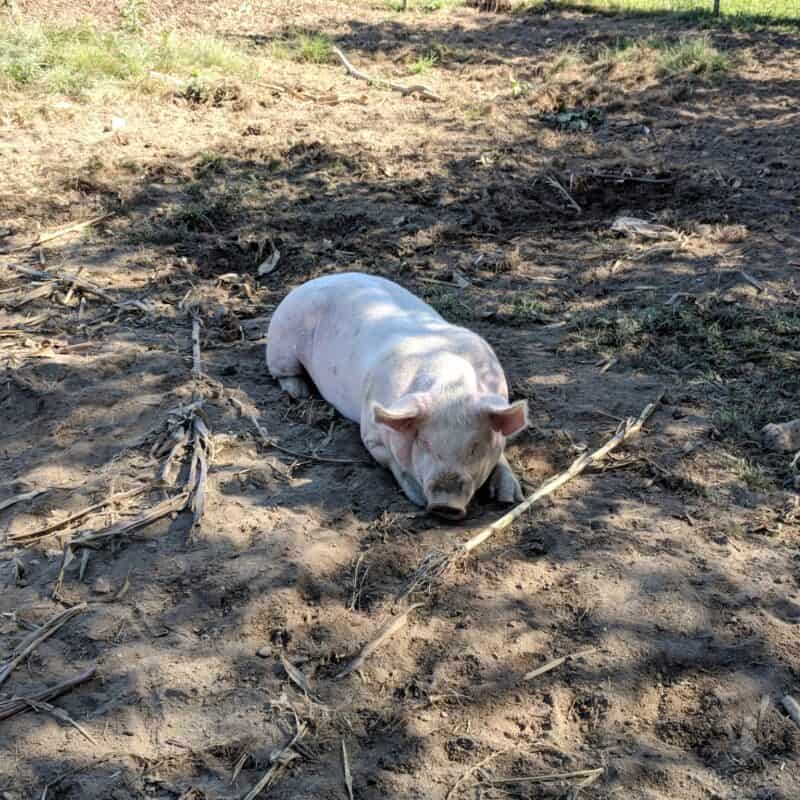
Yorkshire Pig Facts
- These hogs are exceptionally climate adaptable.
- They prefer to forage, graze and thrive in such environments, but also do well when kept in the confinement of a pen.
- Yorkshire hogs are popular with family farmers, homesteaders, and on factory farms.
- Mature members of this breed typically range in size from 600 to 800 pounds (270 to 360 kgs).
- Yorkshire sows typically produce a litter of 10 to 13 piglets twice a year.
- Sows of this breed make good mommas from an easy farrowing, milk production, and protective perspective.
Yorkshire Hog History
When the Yorkshire breed came to America they were known solely as the Large White pig. The breed was created in the Yorkshire region of England in 1761.
Yorkshires first arrived in the United States by way of Ohio. It took until the 1940s for the breed to achieve popularity primarily due to its slow growth rate.
During those many years, the flavorful meat Yorkshires produced along with their massively hardy nature caused them to become beloved to the farmers who keept and breed them.
Selective breeding helped propel the Yorkshire to the popularity the breed enjoys today. Now Yorkshire hogs are found in every state of the Republic, and have achieved their largest numbers in Ohio, Illinois, Iowa, and Indiana.
7. Gloucestershire Old Spots
These hogs are primarily white, and have black spots that dot their bodies. They are notably docile and easy keepers for the most part, and are a good choice for swine newbies.
Gloucestershire Old Spots are highly regarded for their foraging prowess. They are known to turn any scrap that you toss their way into quality lard and meat.
This swine breed was once considered a lard breed, but it is now equally highly regarded for their meat.
Due to the light skin tone, this breed is prone to sun scalding or burning, and must have ample shade and an easily accessible shelter during warm weather months – especially if kept in a hot climate.
Gloucestershire Old Spots Pig Facts
- Sows of this breed average 8 or 9 piglets during their twice a year litters.
- Sows also tend to farrow easily, are attentive mothers, and produce a high and quality level of milk, leading to an above average level of healthy little pigs.
Gloucestershire Old Spots Hog History
This pig breed was created in the Berkley Vale of Gloucestershire region of England in the 1800s.
A lot remains unknown about the development of the Gloucestershire Old Spots pig breed, but it was likely created by the cross-breeding of the original Gloucestershire pig, and the “unimproved” Berkshire.
Gloucestershire Old Spots hogs were nicknamed “cottage pigs” and “orchard pigs” due to their love of agricultural dairy products like whey, and apples.
European folklore claims the black spots that loom large on the back of these hogs were caused by the many apples that fell on their flesh – bruising it, as they rooted around on the ground in orchards, seeking out more apples to munch upon.
The British Board of Agriculture declared that all breeding boars had to be licensed in 1913. Gloucestershire Old Spots keepers felt this would spell the end of the beloved and locally popular breed and started the Gloucestershire Old Spots Breed Society that same year.
This breed’s popularity increased geographically after World War I, when the large amount of lean meat they produced was discovered to create a savory piece of bacon.
Gloucestershire Old Spots pigs arrived in the United States during the early 1900s and were often cross bred with the Chester White and the American Spot breeds.
In livestock shows during the 1920s and 1930s this swine breed became the darling of livestock shows due to the taste of the meat they produced.
After World War II, the shift to factory farming began and caused a rapid decrease in popularity for the Gloucestershire Old Spots breed.
This breed almost became extinct during the 1960s, but has been slowly on the climb in the decades since. In 1995, the Kelmscott Farm Foundation in Maine imported purebred piglets to help re establish this breed in the United States.
That effort and the fact that the British royal family prefers Gloucestershire pork has helped to keep this breed alive, but there are less than 2,000 known breeders left on the planet.
8. Mulefoot
This swine breed boasts hooves that are not cloven, hence the Mulefoot name. These hogs are primarily black with some small white spots on their bodies.
They are another docile breed that is regarded as easy to handle and hardy enough to survive in most climates.
Mulefoot hogs are docile and hardy in most climates. These pigs are better at grazing that foraging but can also do well in confinement. Thanks to their unusually shaped hooves, they tend to maneuver about better in muddy and on marshy terrain.
Mulefoot Pig Facts
- Mature hogs of this breed weigh 400 to 600 pounds (180 to 270 kgs) on average.
- Mulefoot swine produced a marbled meat that is as tasty as it is tender.
- Sows farrow well and are attentive mothers, but have relatively small litters twice a year of only five or six piglets, on average.
- Mulefoot hogs might be the last purebred hog breed in existence.
Mulefoot Hog History
Little is known about the history of this hog breed. Mulefoot pigs may be linked with other breeds that are native to both Asia and Europe, but might have also descended from Spanish hog breeds during the 1500s.
Mulefoot pigs do share some physical characteristics with the Choctaw pig that was only loosely bred until the latter part of the 1800s.
It was not until the early 1900s that standardization of this breed occurred. Mulefoot hogs were bred traditionally for both lard and meat – hams from these pigs were especially prized.
This breed is most commonly found in the Mississippi River Valley, and in island environments.
They have historically thrived without human intervention so much so that they are turned out to forage and graze in the spring, and not collected until the fall for butchering.
9. Hampshire Pigs
These hogs have a definite unusual physique. They are black with a whtie “belt” that runs around their midsection and can cover up all of their front legs. Thanks to their erect ears, Hampshire pigs have highly tuned hearing.
This breed is both docile and curious. Hampshire hogs boast an impressive feed to meat conversion rate. Meat from these pigs are highly regarded for its lean nature – so much so they produce darn little lard.
Hampshire breed members are not a good choice for homesteaders seeking a dual purpose type of swine.
Hampshire hogs grow quite quickly, since they are not a heritage breed.
Hampshire Pig Facts
- Mature members of this swine breed weigh roughly 400 to 600 pounds (180 to 270 kgs).
- Hampshire hogs have ears that prick forward, and sometimes wattle on either side of their necks.
- Sows are good mothers and farrow easily, but typically produce only five or six piglets twice each year. Sowes of this breed are also noted for their calm demeanor.
- Unlike heritage breeds, Hampshire hogs do best under supervised husbandry but can forage well.
Hampshire Hog History
This swine breed is the fourth most populous in America. The Hampshire pig breed may be the oldest American hog breed ever recorded.
The ancestors of modern pigs kept today were imported to the United States from the county of Hampshire England from 1825 to 1835. The breed is believed to have originated in Northern England and Scotland.
10. Chester Whites
These hogs have traditionally been popular with farmers due to their longevity and maternal instincts. Purebred members of this breed should be all white in color or have only very small and limited spots of color.
Chester White hogs produce a carcass that is heavily muscled. They are a heritage pig breed that was created in Chester County, Pennsylvania.
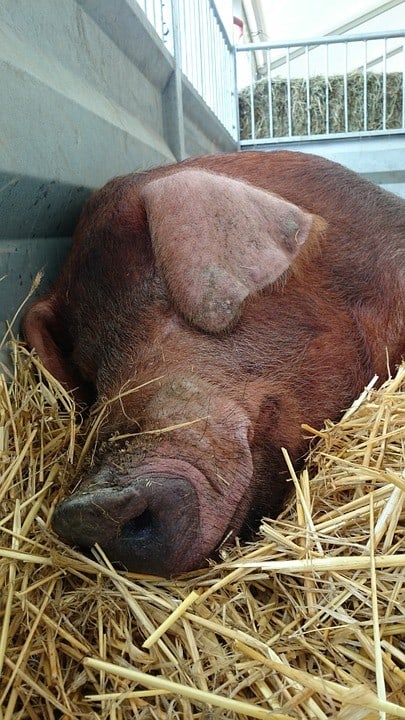
11. Duroc
This is another American hog breed. They have been cross bred with many breeds of quality meat-producing hogs kept at commercial pig farms.
Once upon a time, these reddish brown colored Duroc hogs were regarded as a large breed, but now with the feedlot system at factory farms taking over the pork industry, they’re now regarded as medium-sized.
Members of this swine breed are fairly docile with average or above maternal tendencies by sows. Durocs produce a flavorful and tender meat.
These pigs are usually raised on a foraged and vegetable hay diet.
It is not unusual for Doric hogs to be cross bred with Yorkshires. To improve the foraging prowess and demeanor of the hogs.
12. Landrace
This swine breed was created in Denmark. Pigs of this type are all white with only tiny black marks on their skin if purebred.
Landrace hogs have lopped ears and meaty jowls. They are a large breed and prone to having large litters of piglets twice each year.
Cross breeding with Landrace pigs has become fairly common by farmers seeking to garner larger sized piglets, as well as sows that have excellent maternal instincts and a large quality of milk to care for the baby pigs.
Until the 1930s the Danish government refused to sell Landrace pigs to breeders outside of the country, fearful that doing so would cause their status as the world’s top exporter of bacon to diminish.
When the first breeding stock was allowed to be exported to the United States they were sent here purely for study purpose with a noted understanding that the hogs would not be used to increase the bacon industry in America – only to help bolster existing breeds in the country.
Once the study was completed our government asked the Danish government to end the ban on exporting Landrace hogs, and the request was ultimately granted.
Other Swine Breeds
If none of the above are to your linking, here are even more hog breeds to check out:
- Black Slavonian
- Black Iberian
- Angeln Saddleback
- Czech Improved White
- Arapawa
- Hereford
- Oxford Sandy & Black
- Lacombe
Final Words
There are many quality pig breeds to raise on a homestead, regardless of the amount of acreage that exists.
Keeping hogs in a town or suburban backyard homestead would be difficult, and would require a lot of grain feeding. It could be accomplished if local laws did not forbid such agricultural activities.
Although the pig breeds on this list are all considered very docile, newbie keepers may want to wait until they have at least one year of swine keeping under their belt before purchasing a breeding pair.
Boars are exceptionally large animals. They can become territorial after mating, and even endanger the piglets they produce.
Properly breeding the sow and boar requires both skill and knowledge. When done improperly, one or both of the pigs can be harmed, maimed, or refuse to make a mating attempt ever again.
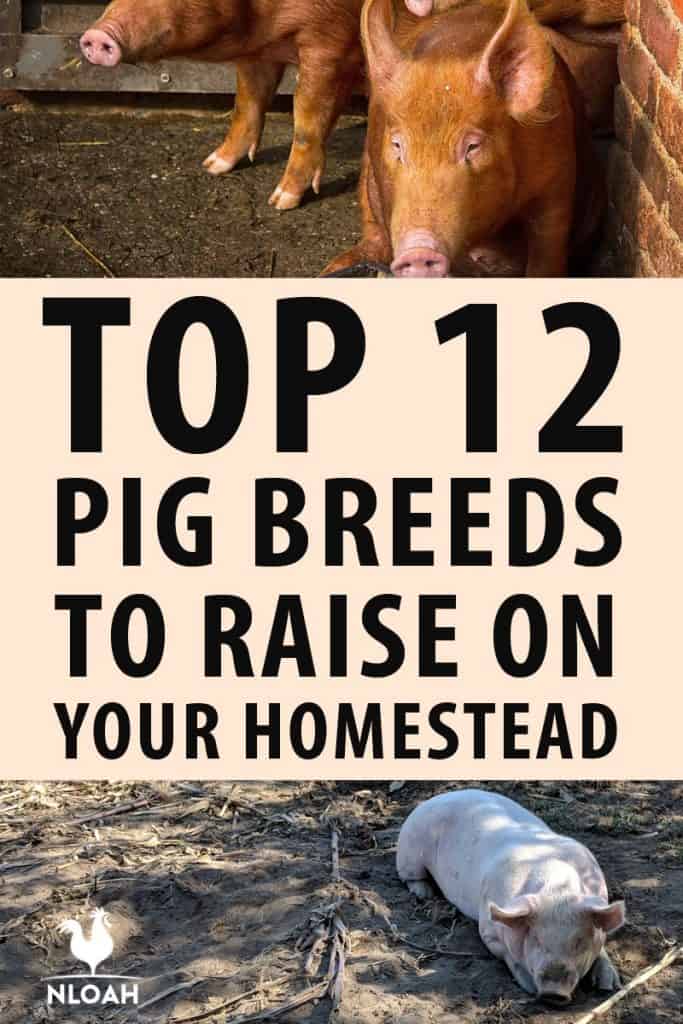

Tara lives on a 56 acres farm in the Appalachian Mountains, where she faces homesteading and farming challenges every single day, raising chickens, goats, horses, and tons of vegetables. She’s an expert in all sorts of homesteading skills such as hide tanning, doll making, tree tapping, and many more.

Thank you SO very much! We’re moving to Appalachia, on a mountainside & coming from SE Louisiana swamps, had no idea which breed would be best & now I know what to expect & how to care for them!